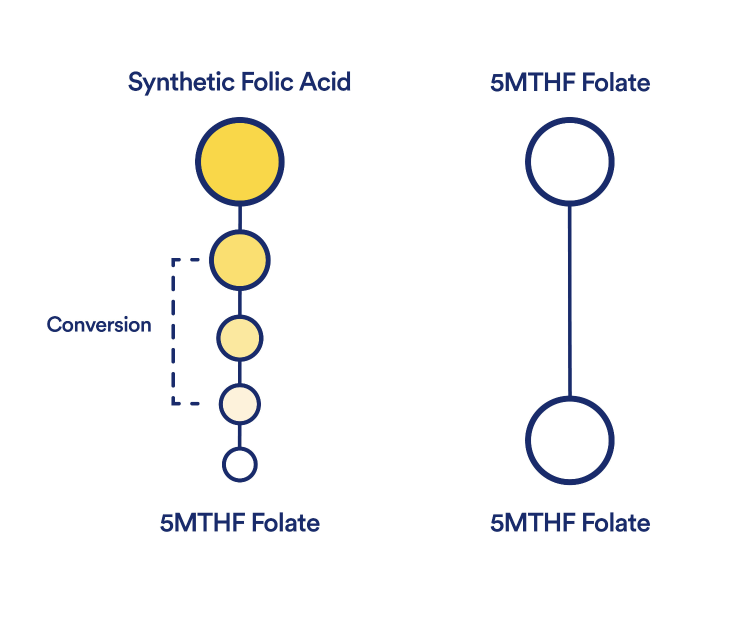PREGNANCY + PARENTHOOD
Folate vs. Folic Acid: Understanding the Difference During Pregnancy
5 min read
Essential Takeaways
- Finding a trusted prenatal is important. That’s why we include folate (not folic acid) in our Essential Prenatal Multivitamin.*
- Folic acid vs. folate: the differences are important when it comes to what we’re putting in our bodies.*
- Let’s explore why we opt for 5-MTHF, the active form of folate, in our multivitamins.*
Meet Essential Prenatal
Support baby’s neural tube and brain development, red blood cell formation and bone health with 12 traceable key nutrients.*
Let’s be clear about one thing: finding a prenatal with folate is really important during pregnancy. In addition to supporting neural tube development for babies, it’s essential for you, too—it’s a B-vitamin known to be involved with DNA methylation (a process related to gene expression). It also supports red blood cell formation. All in all, folate is an important nutrient that needs support from a prenatal multivitamin.*
Notice how we’re emphasizing folate rather than folic acid? That’s because folic acid is a form of folate—it ultimately gets converted in the body to become the active form of folate, 5-MTHF. But while folic acid supplements get a lot of buzz as a prenatal must-have, folic acid may not be the most ideal form of folate for people with a genetic variation that makes it difficult to process. And that’s why we opted for the active form of folate as 5-MTHF while formulating our Essential Prenatal.*
Is Folate the Same as Folic Acid?
The short answer is no! Folic acid is a synthetic form of folate. Folic acid is not naturally found in nature or in our body. It was introduced to our diet through the mandatory folic acid fortification of grain products in 1998. On the flip side, chances are you’re consuming natural folate on a daily basis—food sources include leafy green vegetables, citrus fruits, and legumes such as kidney beans and lentils.
Folate vs. folic acid: It comes down to the way folic acid is converted in the body. Again, when we consume folic acid, it has to be converted to the active form of folate that our bodies can use—which is called 5-methyltetrahydrofolate, or 5-MTHF. And that’s where some people can run into a problem. Up to one-third of adults have a genetic variation that makes it difficult to efficiently convert folic acid specifically—which means that in addition to the genetic issues surrounding folic acid, those with either excess intake of folic acid or the genetic variation may be prone to excess of unconverted folic acid in their bodies.*
This is one of the chief reasons why we opted for 5-MTHF, the active form of folate we include in our multivitamins—helping to bypass that tricky folic acid-to-folate conversion. The National Institutes of Health (NIH), which is the steward of medical and behavioral research for the nation, calls 5-MTHF the “active form of folate” and reports that supplementation with 5-MTHF might be more beneficial than with folic acid for people with this genetic variation.* (2)

Finding a Prenatal With Folate Not Folic Acid
Many prenatal multivitamins only use folic acid. In fact, all five best-selling prenatal multivitamins use the synthetic form of folate, folic acid. Which begs the question: if this genetic variation is prevalent, and the NIH suggests that 5-MTHF might be the more beneficial alternative for some, why stick with folic acid?†*
†Based on the top 5 US prenatal multivitamin brands by 2019 & trailing 12 month retail sales (through April ’20)
There are a few reasons—namely, that folic acid has a long history of use from mandatory fortification of grains to use in supplements for many years. Folic acid has been known as a shelf-stable and more cost-effective version of folate. (It’s been so popular for so long, chances are you know the term “folic acid” more than “folate.”) Because of this use history and popularity as an ingredient, many pregnancy supplementation studies have relied on data from folic acid—which means that many companies developing prenatal multivitamins stick to the popular choice.
Folic Acid vs. Methylated Folate (5-MTHF) in Pregnancy
Folic acid and methylated folate as 5-MTHF are different forms of the same nutrient (folate) that both help support adequate folate levels, a key determinant in healthy neural tube development. The Food and Drug Administration (FDA) takes a position—with significant scientific agreement from qualified health experts—that maintaining adequate folate intake may reduce the risk of neural tube defects in pregnancy. As part of this, the FDA does not agree that folic acid is the only form of folate to help reduce the incidence of neural tube defects.(1)
The FDA further explains that “the diet/disease relationship is more accurately described as being related to all of the biologically active vitamin forms of folate rather than just to the synthetic form of the vitamin (i.e., folic acid).” We agree with the FDA’s comments. Bottom line? The utility of increased folate intake in support of maintaining adequate folate levels is what is of importance, whether achieved through folic acid or folate.* (1)
Our Clinical-Backed Approach to Folate
In line with FDA, NIH, and other scientific research, our goal is simple: to support adequate folate intake, while being as inclusive as possible. In other words, we just didn’t think it made sense to develop a prenatal multivitamin that relied solely on a form of folate as folic acid, which up to one-third of women might not be able to use efficiently. Further to this, we wanted to avoid excess of unconverted folic acid given the trending research in this area.*
And we’re proud to share that we completed a clinical study that underlines our goal of supporting folate levels via 5-MTHF. Our university-led clinical study has been accepted for publication in the international peer-reviewed journal of Frontiers in Nutrition and showed that Essential for Women 18+, which uses the same form of folate as 5-MTHF and dosage (1000 mcg DFE) as Essential Prenatal, significantly increased folate levels in women of reproductive age.*
References:
1. Food and Drug Association. Department of Health and Human Services. (1996). Food Labeling: Health Claims and Label Statements; Folate and Neural Tube Defects. Federal Register, 61(44).
2. U.S. Department of Health and Human Services. (n.d.). Office of Dietary Supplements – Folate. NIH Office of Dietary Supplements. https://ods.od.nih.gov/factsheets/Folate-HealthProfessional/#h8.
Meet Our Expert

Dr. Luke Bucci, PhD, CCN, CNS, Research and Technical Fellow
Dr. Luke Bucci received a PhD in Biomedical Sciences from the University of Texas and has over thirty years of experience in the nutrition industry, encompassing all aspects of scientific applications. He has brought blockbuster products to market, written books, patents and numerous articles, and developed certification programs for clinical nutritionists.
Meet the Author

Victoria Hoff, Writer
Victoria Hoff is an accomplished writer, journalist, and former wellness editor who has covered a wide variety of health, nutrition, and wellness topics during her tenure. She graduated Magna Cum Laude with a Bachelor of Arts from New York University, and after writing for Vogue, Elle, Byrdie, The/Thirty, and more, channeled her editorial skills into a marketing career.